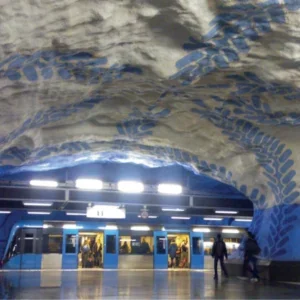A stormwater diversion tunnel is nearly ready to face the rainy season in Genoa, Italy. After a disastrous flood in 2011, which caused the death of six people, a water diversion tunnel to collect waters from Fereggiano torrent has gained strong support.
The tunnel intercepts the Fereggiano torrent once it exceeds a certain level. The water drops down a 42m-deep shaft and then into an expansion chamber, before being fed into a 3.7km-long, 5.2m-diameter tunnel before flowing to the sea.
Excavation began in 2015 and the tunnel has been fully excavated and final lining work is ongoing. Pierfrancesco Redaelli, project engineer for PAC adds, “We are also currently working on the water intake structure and expansion chamber, and also the sea outlet. All works should be complete by early 2019.
Ground conditions
Geology in the area consists of sand deposits, alluvial and filling materials, Ortovero Clay, Monte Antola Flysch, fine-grained sedimentary rock. Strengths along the alignment have varied from 5 to 160MPa.
The mainstay of the geology is the Flysch from Mount Antola, which alternates in layers with limestone and marly limestone in thicknesses of 1-1.5m. There are also clay interlayers with thicknesses in the decimetres, as well as compact mudstone.
Spoil removal
Spoil has been removed by sea on barges to minimise traffic congestion. Close to the outlet structure the contractor has built a shed for crushing spoil as needed. Some of the spoil has been used for concrete aggregate, some is used for beach improvements and some is removed to landfill for further treatment.
Spoil was handled by a CAT 938 Wheel Loader and a Paus PMK 10,000 Dumper.
Excavation
The tunnel was advanced from the outfall towards the dropshaft, with only one excavation face and so only one machine in use at the time. The water tunnel was mainly excavated by drill and blast except at some critical points where a road header has been used.
Drill and blast was by a Robodrill jumbo with an Atlas Copco hydraulic hammer. Two roadheaders were used: a 130kW Alpine Westfalia boom on a Liebherr 942 and a Simex 80kW on a Hitachi 240.
Advance rates achieved were:
- 3.5m/day with drill and blast where the drilling depth had to be limited to control surface vibrations
- 2m/day with roadheader in clays
- 1m/day with roadheader in rock
Alcoves were excavated every 500m for transportation and safety purposes during construction. These will be concreted in prior to tunnel operation.
Monitoring and crossing a railway
“One challenging area was beneath some masonry railway tunnels dating from 1850,” he says. “We had to go through with low cover, almost 3.5m beneath the tunnels. These tunnels are a horseshoe shape without any closure at the invert.
“We were concerned about going underneath the subway of railway tunnels. The main fear was creating a differential subsidence between the two rails, exceeding the track twist limit. Differential subsidence can cause derailment.”
The teams employed a roadheader instead of drill and blast excavation for a 60m section and proceeded with caution, checking any distortion on the track along the longitudinal and diagonal. However, the rock was in good condition in this area, and with the reduced vibrations of the roadheader, no problems resulted.
The team also installed a micro-piled umbrella arch as a precaution to protect the railway.
Damiani says that they had also played with 3D model calculations in addition to sensitivity analysis. “We had to amend some geotechnical parameters and then, we degraded them to explore the worst case scenarios.
“We also carried out a daily monitoring to continuously check tracks, and to have a feedback throughout excavation works. The monitoring system is not only to check any track distortion but also for vibrations, which can be caused by a perforation in the rock. So we installed some vibrometers to monitor vibrations.”
Monitoring instruments include electro levels fitted with crossbars on the tracks; targets inside the cable where workers checked every day with RFI personnel for topographical monitoring.
As the project is located in a dense urban area, some vibrometers have been fitted on building to measure vibrations during the excavation.
“There were noise restrictions between 10pm to 6am, therefore we couldn’t use any explosive during that time to avoid any disturbance to residents,” says Redaelli. “As we were excavating within a rock at a depth of 60-70m, vibrations could be quite strong. Thus, these vibrometers were moved from time to time to monitor the level of vibrations induced during the excavation.
“We adjusted the whole amount of perforations on the face to optimise the efficiency of excavation, the profile of excavation in the tunnel. In this way, we avoided digging out and causing too many vibrations.”
Lining
Lining consists of inverted arch cast-in-situ with reinforced concrete. The dimensions are 5.09m long, 5.2m wide and 400mm deep.
“The lining of the sidewall and the crown was expected in the preliminary design to be cast-in-situ with a sliding caisson,” Damiani says. “During the final design we changed the construction system of the lining, relying on prefabricated selfsupporting slabs placed on the invert’s sidewalls. They form an arch with three joints, two at the bottom (base) and one as key.
“These prefabricated slabs are reinforced with steel lattice girders, which is locally integrated with a (slow) normal reinforcement and then it is cast-in-situ. That was relevant to speed up the lining execution.”
Damiani explains that the lining design was amended during construction planning for construction reasons, such as programme timings and the elimination of interference from a sliding caisson. The thickness of the prefabricated element is 100mm (reinforced concrete); the height of the prefabricated element with iron framework is 260mm; the lining circumference is about 11m; the transversal length of the prefabricated element is 2.5m.
“Amongst the main advantages of using pre-fabricated structural elements in terms of concrete maturity, there is the durability as they fully reduce effects of hygrometric shrinkage, specifically the surface exposed to the air, which is protected by prefabricated slabs,” Damiani adds.
Damiani explains that the water tunnel doesn’t need to be waterproofed, as there is a little water seepage, being placed as it is in rocky geology.






